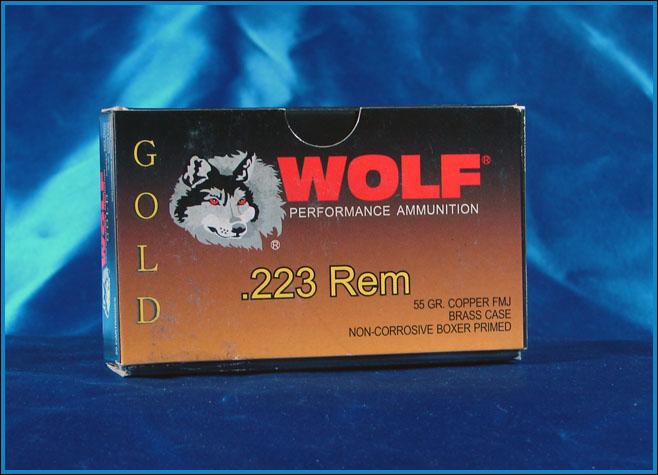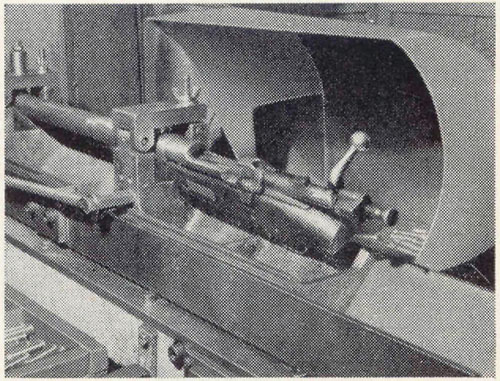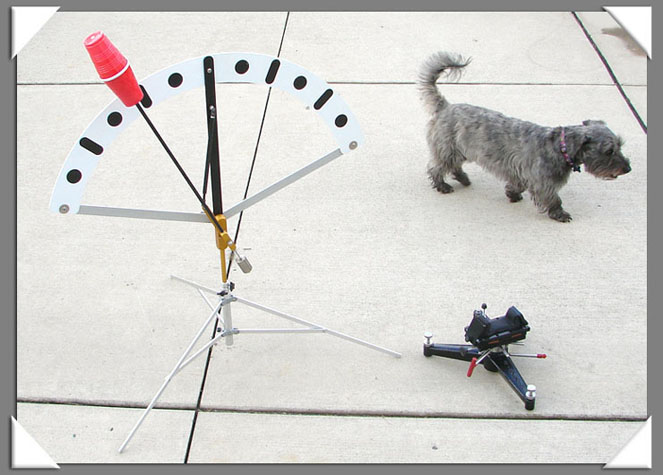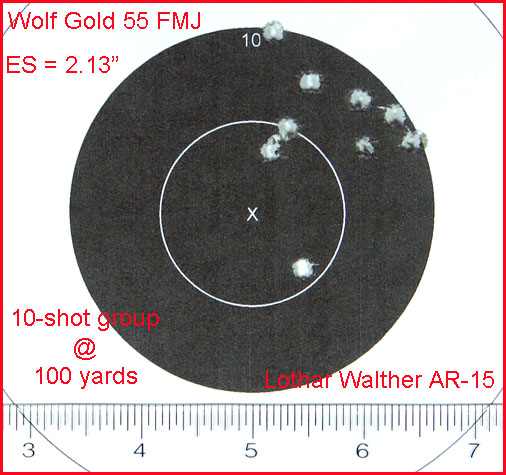

When most shooters hear the phrase “Wolf ammunition,” what usually comes to mind is steel-cased rounds loaded with bi-metal jacketed bullets. Fortunately, the 55 grain FMJ “Wolf Gold” ammunition that is manufactured in Taiwan does not fit this description.
The Wolf Gold ammunition reviewed for this report uses brass cases with the annealing iris still visible and is loaded with typical copper jacketed/lead core bullets. The 55 grain projectile has a cannelure and there is a collet crimp at the case mouth. The case mouth is also sealed with asphalt sealant. The brass case has crimped and sealed boxer primers and the round is charged with ball powder.



When most shooters hear the phrase “55 grain FMJ,” what usually comes to mind is M193 ammunition. The velocity specification for M193 as cited in MIL-C-9963F states:
The average velocity of the sample cartridges, conditioned at 72 degrees, plus or minus 2 degrees Fahrenheit (F), shall be 3165 feet per second (ft/sec), plus or minus 40 ft/sec, at 75 feet from the muzzle of the weapon. The standard deviation of the velocities shall not exceed 40 ft/sec.
The specification is for a 20” barrel. Depending on multiple variables, this velocity specification equates to a muzzle velocity of approximately 3270 FPS, plus or minus 40 FPS. I chronographed the Wolf Gold 55 grain FMJ ammunition from a semi-automatic AR-15 with a chrome-lined, NATO chambered 20” Colt M16A2 barrel.

Chronographing was conducted using an Oehler 35-P chronograph with “proof screen” technology. The Oehler 35P chronograph is actually two chronographs in one package that takes two separate chronograph readings for each shot and then has its onboard computer analyze the data to determine if there is any statistically significant difference between the two readings. If there is, the chronograph “flags” the shot to let you know that the data is invalid. There was no invalid data flagged during this testing.
The velocity stated below is the muzzle velocity as calculated from the instrumental velocity using Oehler’s Ballistic Explorer software program. The string of fire consisted of 10 rounds over the chronograph.


Each round was single-loaded and cycled into the chamber from a magazine fitted with a single-load follower. The bolt locked-back after each shot allowing the chamber to cool in between each shot. This technique was used to mitigate the possible influence of “chamber-soak” on velocity data. Each new shot was fired in a consistent manner after hitting the bolt release. Atmospheric conditions were monitored and recorded using a Kestrel 4000 Pocket Weather Tracker.
The muzzle velocity for the 10-shot string of the Wolf Gold 55 grain FMJ ammunition was 3213 FPS with a standard deviation of 25 FPS. For comparison, IMI M193 had a muzzle velocity of 3274 FPS when fired from the same barrel, with a standard deviation of 18 FPS.

Atmospheric conditions
The accuracy specification for M193 cited in MIL-C-9963F is as follows: The average of the mean radii of all targets of the sample cartridges, fired at 200 yards, shall not exceed 2.0 inches.
These averages are from 10-shot groups fired from machine rested, bolt-actioned test barrels, such as the ones pictured below. All things being equal (which of course they seldom are) this specification equates to a mean radius of 1 inch at 100 yards for 10-shot groups.


I conducted an accuracy (technically, precision) evaluation of the Wolf Gold 55 grain FMJ ammunition following my usual protocol. This accuracy evaluation used statistically significant shot-group sizes and every single shot in a fired group was included in the measurements. There was absolutely no use of any group reduction techniques (e.g. fliers, target movement, Butterfly Shots).
The shooting set-up will be described in detail below. As many of the significant variables as was practicable were controlled for. Also, a control group was fired from the test-rifle used in the evaluation using match-grade, hand-loaded ammunition; in order to demonstrate the capability of the barrel. Pictures of shot-groups are posted for documentation.
All shooting was conducted from a concrete bench-rest from a distance of 100 yards (confirmed with a laser rangefinder.) The barrel used in the evaluation was free-floated. The free-float handguards of the rifle rested in a Sinclair Windage Benchrest, while the stock of the rifle rested in a Protektor bunny-ear rear bag. Sighting was accomplished via a Leupold VARI-X III set at 25X magnification and adjusted to be parallax-free at 100 yards. A mirage sheild was attached to the objective-bell of the scope. Wind conditions on the shooting range were continuously monitored using a Wind Probe. The set-up was very similar to that pictured below.

The Wind Probe.

The test vehicle for this evaluation was one of my semi-automatic precision AR-15s with a 20” stainless-steel Lothar Walther barrel. The barrel has a 223 Wylde chamber with a 1:8” twist.
Prior to firing the Wolf Gold ammunition, I fired a 10-shot control group using match-grade hand-loads topped with the Sierra 55 grain BlitzKing. That group had an extreme spread of 0.78”.

Next, three 10-shot groups of the Wolf Gold were fired in a row with the resulting extreme spreads:
for a 10-shot group average extreme spread of 2.39”. The three 10-shot groups were over-layed on each other using RSI Shooting Lab to form a 30-shot composite group. The mean radius for the 30-shot composite group was 0.76”.
The smallest 10-shot group.

The 30-shot composite group.
